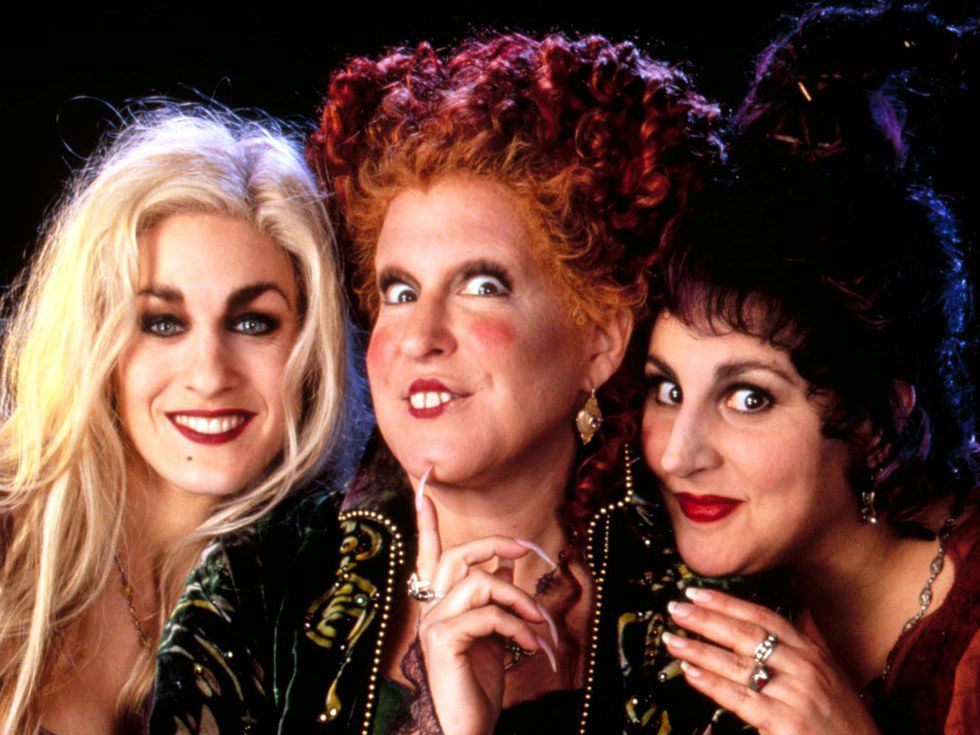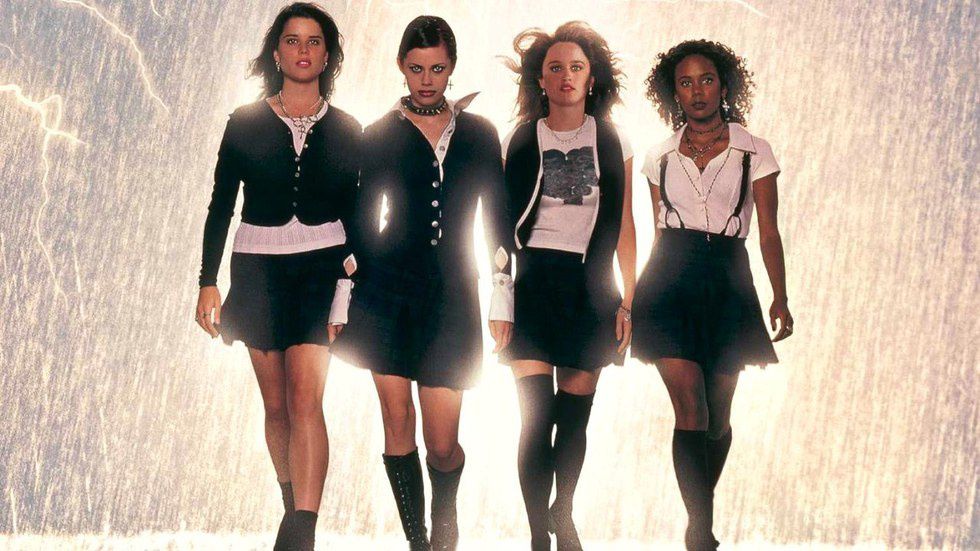If you google “witch”, the first definition that appears is: a woman thought to have evil magic powers; witches are popularly depicted as wearing a black cloak and pointed hat, and flying on a broomstick. This is not the case, though. Despite how “unrealistic” or “ridiculous” it sounds--witches are real. In movies, television, and popular culture where witches are portrayed, they can be seen in a negative light. However, most of the time the portrayal of witches is unrealistic. Through such movies and television shows, people have been altered to view witches negatively, often based on stereotypes. These stereotypes include the pointy black hats, flying on broomsticks, black cats, and spell books. There is also a certain “‘inhuman” look witches are seen as--the pointy chin, wart-nosed, raggedy woman. But in reality, witches look like everyone else and you probably walk amongst them daily. Witches also aren’t evil, and aren’t linked to Satanism. In short, people who identify as witches can practice witchcraft: a spiritual practice that focuses on the individual, and encourages the understanding of nature and earth. People can be witches and practice only witchcraft, but some can be witches and be Wicca. Wicca is a religion associated with witches. Wiccans believe in “the spirit of the One, Goddess and God exist in all things.” They treat all objects on Earth with respect. Some witches are both Wiccan and practice witchcraft. As I said before, these truths behind witches are twisted in popular culture through movies and television shows.
"Hocus Pocus"
 "Hocus Pocus" is my all time favorite Halloween movie, so it hurts me to say that the portrayal of the three witches are extremely stereotypical and inaccurate. The plot goes as follows: Max Dennison and his family moves to Salem, Massachusetts--where the infamous Salem Witch Trials took place. And in the film, in 1692, the three Sanderson sisters fed on children’s souls, turned a boy into a black cat, and as a result got hanged for it--but not before they said a chant that allowed them to be revived. In the 1990’s, Max accidentally brings them back to life, where they plan to feed on modern-day Salem’s children, especially Max’s younger sister. Throughout the whole movie, the witches chase Max and the gang who took their beloved spell book, fly on broomsticks, worship a man dressed as Satan, and somehow a zombie is mixed in the madness. All in all, "Hocus Pocus" adds to the stereotypes. Witches do not feed on children, fly on broomsticks, or worship Satan. Real witches also don’t have the ability to turn a teenage boy into a black cat. Everything in this movie can be seen as offensive to real witches, despite how beautifully magical it is.
"Hocus Pocus" is my all time favorite Halloween movie, so it hurts me to say that the portrayal of the three witches are extremely stereotypical and inaccurate. The plot goes as follows: Max Dennison and his family moves to Salem, Massachusetts--where the infamous Salem Witch Trials took place. And in the film, in 1692, the three Sanderson sisters fed on children’s souls, turned a boy into a black cat, and as a result got hanged for it--but not before they said a chant that allowed them to be revived. In the 1990’s, Max accidentally brings them back to life, where they plan to feed on modern-day Salem’s children, especially Max’s younger sister. Throughout the whole movie, the witches chase Max and the gang who took their beloved spell book, fly on broomsticks, worship a man dressed as Satan, and somehow a zombie is mixed in the madness. All in all, "Hocus Pocus" adds to the stereotypes. Witches do not feed on children, fly on broomsticks, or worship Satan. Real witches also don’t have the ability to turn a teenage boy into a black cat. Everything in this movie can be seen as offensive to real witches, despite how beautifully magical it is.
"The Craft"
 Similar to "Hocus Pocus", a new kid moves to town and ends up igniting something dangerous and life threatening. After Sarah Bailey moves to Los Angeles, she befriends a group of girls who are known to be witches, and need a fourth member of their coven to complete rituals. After various abuses of their powers, their spells being negative consequences. At the end, Sarah tries to stop the girls from such harm, but they all turn on her. Sarah is haunted in her dreams, threatened, and lead to believe her father had been killed--all done by her former coven members. They also try to get Sarah to commit suicide. In the end, Sarah defeats these evil witches who practice “The Craft”. There are various examples of stereotypes, such as how the witches are portrayed as evil and power hungry. Everything that they do goes against what witchcraft stands for. Witchcraft stands to invoke positive change in oneself, not to hurt other people. In fact, witches take an oath not to harm others, called the Wiccan Rede. The Craft not only contradicts what true witchcraft is, but it portrays witches as goth, unstable, teen girls who use powers to benefit themselves.
Similar to "Hocus Pocus", a new kid moves to town and ends up igniting something dangerous and life threatening. After Sarah Bailey moves to Los Angeles, she befriends a group of girls who are known to be witches, and need a fourth member of their coven to complete rituals. After various abuses of their powers, their spells being negative consequences. At the end, Sarah tries to stop the girls from such harm, but they all turn on her. Sarah is haunted in her dreams, threatened, and lead to believe her father had been killed--all done by her former coven members. They also try to get Sarah to commit suicide. In the end, Sarah defeats these evil witches who practice “The Craft”. There are various examples of stereotypes, such as how the witches are portrayed as evil and power hungry. Everything that they do goes against what witchcraft stands for. Witchcraft stands to invoke positive change in oneself, not to hurt other people. In fact, witches take an oath not to harm others, called the Wiccan Rede. The Craft not only contradicts what true witchcraft is, but it portrays witches as goth, unstable, teen girls who use powers to benefit themselves.
"The Wizard of Oz"
 "The Wizard Of Oz" is a classic movie about a girl named Dorothy who travels to the land of Oz during a tornado and must endure a journey in order to get back home. The conflict arises when Dorothy’s house lands on and kills the “Wicked Witch of the East”. Her death influences the munchkins to sing and celebrate, letting the viewers assume that this witch had some kind of dictator-like control over them. As a result, the Wicked Witch of the West wants revenge on Dorothy. Though there is a good witch involved who assists Dorothy along the way, viewers don’t come away from the movie associating “good” with witches. The impact of the evil witch contributed to much of what popular culture identified as a witch. These characteristics, such as green-skin, pointy-nose, cackling hags who fly on broomsticks, is the most common appearance associated with witches. Because of the Wizard of Oz, popular culture was influenced and people were made under the impression that this is what a witch was, and that they were evil and bitter.
"The Wizard Of Oz" is a classic movie about a girl named Dorothy who travels to the land of Oz during a tornado and must endure a journey in order to get back home. The conflict arises when Dorothy’s house lands on and kills the “Wicked Witch of the East”. Her death influences the munchkins to sing and celebrate, letting the viewers assume that this witch had some kind of dictator-like control over them. As a result, the Wicked Witch of the West wants revenge on Dorothy. Though there is a good witch involved who assists Dorothy along the way, viewers don’t come away from the movie associating “good” with witches. The impact of the evil witch contributed to much of what popular culture identified as a witch. These characteristics, such as green-skin, pointy-nose, cackling hags who fly on broomsticks, is the most common appearance associated with witches. Because of the Wizard of Oz, popular culture was influenced and people were made under the impression that this is what a witch was, and that they were evil and bitter.
"The Blair Witch Project"
 This movie is styled as a documentary, about three film students who seek to find the truth about a local murderer- the Blair Witch. They interview townspeople who warn them that this murderer is known to kill children. The students start to investigate in the woods, where the witch is said to live, and strange occurrences happen. They hear sounds, find graves, and find that their items were looked through. On the sixth day in the woods, one of them disappears and his remains (bloody shirt, teeth, hair, and a piece of his tongue) are found. When they hear his screams, they are lead to a house with symbols and children’s bloody hand prints on the walls. In the end, they all are killed. The movie portrays this witch as a child-killing, murderous, torturous, psycho woman. Every facet about how this movie identifies a witch is false and untrue.
This movie is styled as a documentary, about three film students who seek to find the truth about a local murderer- the Blair Witch. They interview townspeople who warn them that this murderer is known to kill children. The students start to investigate in the woods, where the witch is said to live, and strange occurrences happen. They hear sounds, find graves, and find that their items were looked through. On the sixth day in the woods, one of them disappears and his remains (bloody shirt, teeth, hair, and a piece of his tongue) are found. When they hear his screams, they are lead to a house with symbols and children’s bloody hand prints on the walls. In the end, they all are killed. The movie portrays this witch as a child-killing, murderous, torturous, psycho woman. Every facet about how this movie identifies a witch is false and untrue.
These are just a few examples of the stereotypes of witches in movies. We can stem this negative attitude towards witches back to the various
crimes against people who were accused of being witches, both in America and Europe way back when. But in our current society, these stereotypes are made from influences in pop culture. People still view witches as evil, Satan worshiping, people who use animal and human sacrifice. In reality, all that witches do is follow their belief system, whether it be witchcraft, Wicca, or both.






















